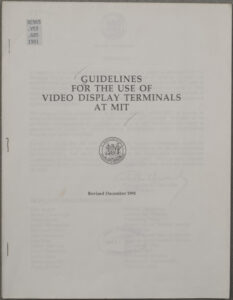 Published: Cambridge, Mass., 1991
Published: Cambridge, Mass., 1991
It’s not much to look at, but Guidelines for the Use of Video Display Terminals at MIT serves as a sort of time capsule. It also provides a specific example of the concern that arises whenever new technology is introduced into the workplace.
Today computers and computer monitors are a central part of the daily life of the entire MIT community, but in 1991 such equipment was still quite new. This publication was prepared in response to “a proposal submitted by the Working Group on Support Staff Issues.” It was created by the Ad Hoc Video Display Terminal Committee, which included representatives from MIT’s Medical Department, Environmental Medical Service, and Safety Office.
Like cell phone customers today, users of video display terminals (VDTs) in 1991 had reasonable questions about the possibility of radiation exposure from their monitors. The Guidelines respond to these concerns through careful explanation of what electromagnetic radiation is, and the kinds and levels of radiation that are emitted by VDTs.
The document states, for example, that “the intensity of UV radiation emitted from VDTs is lower than that from fluorescent lights and much lower than that from the sun.” The MIT community was also assured that “the units are designed and shielded such that levels of X-ray emission do not exceed federal limits, and most often are not measurable above natural background radiation.” The publication goes on to address fears about VDTs and human reproductive hazards, since news stories at the time were raising questions about a possible relationship between VDT use and the incidence of birth defects and miscarriages.
Many of the ergonomic recommendations in this document remain valid. Accessories such as document holders, foot rests and wrist rests were recommended then, just as they’re recommended for certain users today.
The report acknowledges that
until the 1970’s, it was believed that only factory and office workers would be the victims of injuries associated with repetitive tasks. This is no longer true due to the influx of personal computers and mainframes which have become essential to the daily tasks of not only administrative and support staff, but also of students and faculty who opt to type their manuscripts, course material, etc.
This document with its rough graphics (featuring boxlike computer monitors) may now qualify as quaint. But by releasing publications such as this, MIT has continued to reaffirm its Environmental, Health and Safety Policy of “minimizing, as feasible, the adverse environmental, health and safety impacts of our facilities, activities and operations to protect human health and the environment (which is one way we define sustainability).”
